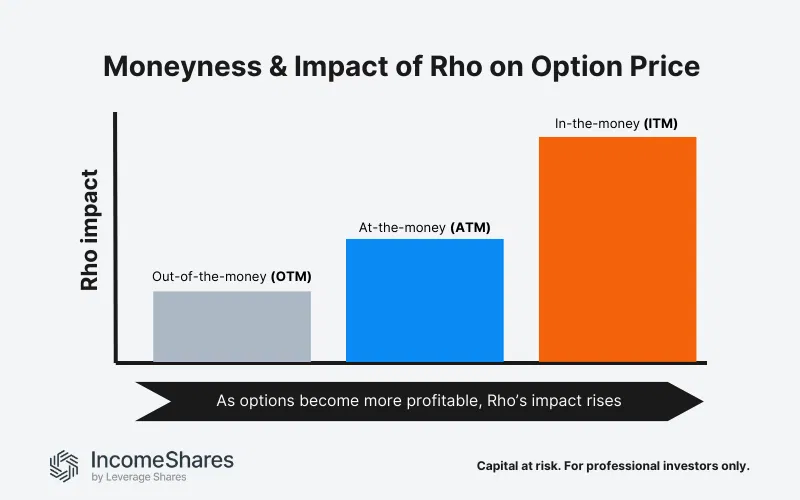
Author
Jonathan Hobbs, CFA
Date
02 Dec 2024
Category
Market Insights
Rho Explained: How Interest Rates Move Option Prices
Your capital is at risk if you invest. You could lose all your investment. Please see the full risk warning here.

Rho is an options “Greek” that doesn’t get as much attention as Delta or Vega. But understanding it can be useful for options traders – especially during times of changing interest rates. In this guide, we’ll explain what Rho is and how it works with options pricing.
What is Rho in options?
Rho measures how much the price of an option (the option premium) moves with a 1% change in interest rates. In other words, it measures the sensitivity of an option’s price to interest rate movements. It’s typically expressed as a dollar amount.
Here’s how it works with call and put option prices:
Call options (right to buy): Rho is positive. When interest rates rise, call options usually increase in value. With higher interest rates, investors can earn higher yields on their cash. And that can make buying a stock less appealing to them.
But buying a call option? That’s more appealing, since investors could still get upside on the stock for a small upfront premium – leaving them with more cash to earn yields. In this case, investors can have their cake and eat it.
To learn more about call options, check out our call options guide.
Put options (right to sell): Rho is negative. If interest rates rise, put options generally lose value. Higher rates can still make holding cash more attractive for investors. So, they’re less likely to spend money on a put option to bet or hedge that a stock will fall.
There’s simply less reason to pay for downside protection – their cash is already working harder for them.
To learn more about put options, see our put options guide.

Why should options traders pay attention to it?
Rho may seem like a minor factor compared to Delta or Vega. But it becomes more relevant in certain market environments – like when interest rates are moving. Here’s why Rho is worth keeping an eye on:
Interest rate sensitivity: When interest rates change, it can directly affect option premiums, especially for longer-term options. A 1% interest rate rise might slightly boost call option prices and decrease put option prices.
Longer expiration: Rho has a bigger impact on options with a longer time to expiration. That’s because there’s more time for those rates to impact the option’s price. Meanwhile, short-term options usually aren’t affected as much by interest rate changes.
Market environment: Rho can be useful for traders who anticipate interest rate hikes or cuts. These can influence the profitability of options strategies – especially for longer-term positions.
Rho and option “moneyness”
Rho’s effect on an option also depends on its “moneyness” (whether it’s in-the-money, at-the-money, or out-of-the-money). Here’s how:
In-the-money (ITM): For ITM options, Rho has a bigger impact because these options already have intrinsic value. Changes in interest rates can add to the appeal of call options or reduce the appeal of puts. After all, the options are already in a position to benefit from price movements in the underlying stock.
At-the-money (ATM): ATM options tend to have moderate Rho sensitivity. Since they’re right on the edge of profitability, changes in interest rates can still slightly affect their price – though less than with ITM options.
Out-of-the-money (OTM): OTM options generally have the lowest Rho sensitivity. Because these options don’t yet have intrinsic value, they’re less responsive to interest rate changes. Their value is more tied to the likelihood of moving into profitability (in the money) rather than the impact of rates on their existing value.
Bottom line: The more profitable (in the money) the option already is, the bigger the impact of Rho on the option price.

Example: How Rho impacts the price of a call option
Let’s say you have a long-term call option with a Rho of 0.05. If interest rates rise by 1%, the price of your call option would increase by about $0.05. It might seem small, but over big positions or longer terms, these shifts can add up – especially in volatile interest rate times.
Key takeaways
Rho measures an option’s sensitivity to a 1% change in interest rates.
Higher interest rates typically increase call option prices and decrease put option prices.
Rho matters most for long-term options and during times of changing interest rates.
Your capital is at risk if you invest. You could lose all your investment. Please see the full risk warning here.
Related Products:
Strategy
Cash-Secured Put + Equity
Distribution Yield
62.95%
Strategy
Cash-Secured Put + Equity
Distribution Yield
41.66%
Strategy
Covered Call
Distribution Yield
16.85%
